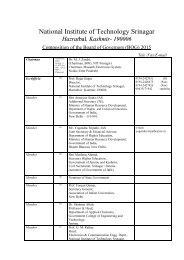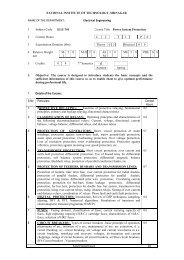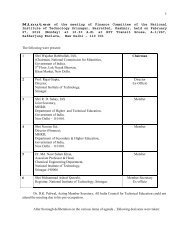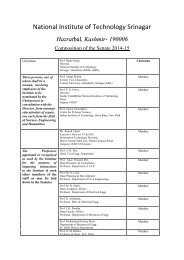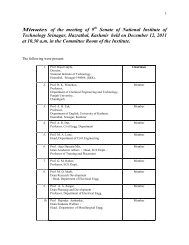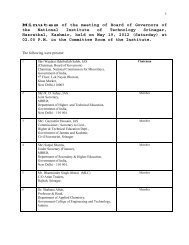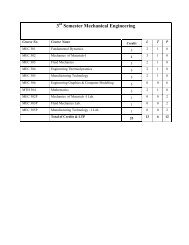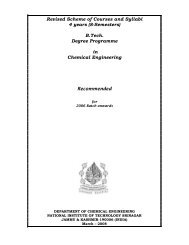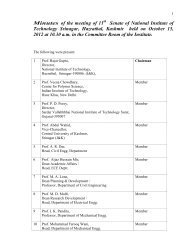Syllabus (6th Semester) - NIT Srinagar
Syllabus (6th Semester) - NIT Srinagar
Syllabus (6th Semester) - NIT Srinagar
Create successful ePaper yourself
Turn your PDF publications into a flip-book with our unique Google optimized e-Paper software.
NATIONAL INSTITUTE OF TECHNOLOGY, SRINAGARNAME OF THE DEPARTMENT:Electrical Engineering1 Subject Code ELE-601 Course Title POWER SYSTEM -112 Contact Hours: 42 L 3 T 1 P3 Examination Duration (Hrs): Theory 0 3 Practical4 Relative Weight age M-I 2 0 M-II 2 0 ASM 1 0 ME 5 0 PRE 0 05 Credits: 0 5 <strong>Semester</strong>6 Objective:AutumnSpring7. Details of the Course:S.No Particulars Contact Hours1.Per Unit Representation of Power Systems:Single line diagram, impedance and reactance diagram of a system, per unit 6calculations, per unit representation of a power system.2. Fault Analysis (Balanced Faults:6Faults, types of faults, symmetrical 3-phase balanced faults – calculation of faultcurrents, current limiting reactors.3. Fault Analysis (Un-symmetrical Faults)8Symmetrical components, sequence impedances, sequence networks, unsymmetricalfaults –single line to ground, line-to-line, double line to ground faults on unloadedalternators and on power systems,4. Insulation Co-ordination:Generation of over-voltages in a power system, lightning phenomena, lightning8surges, switching surges-interruption of short circuits and switching operations,switching surges – interruption of capacitive circuits, resonance over voltages,protection of power system components against over voltages – ground wires,lightning arrestors. Concept of insulation coordination, Basic impulse insulation level,standard impulse test wave, volt-time curve, location and rating of lightning arrestors.5. Surge Performance of Transmission Lines:6Traveling waves on transmission lines, open-end line, short-circuited line, lineterminated through a resistance, line connected to a cable, reflection and refraction ata T-junction, line terminated through a capacitance, line terminated through aninductance, Attenuation of traveling waves.6. Interference of Power Lines with communication Circuit Electrostatic and 2Electromagnetic effects. .7.High Voltage Direct Current Transmission & FACTS TechnologyComparison of HVAC and HVDC transmission lines. Thyristors (brief revision). Basic 6converter and D.C system operation – rectification, inversion. Complete directioncurrent link. Objective of FACTS. Basic types of FACTS controllers. Introduction toFACTS Devices.Total Contact Hours 428. Suggested Books:S.No Name of Book Author Publisher Date of publishing1 Power System Analysis J.J. Grainger and W.D Tata McGraw Hill 1994Stevenson2 Electrical Power Systems. C.L. Wadhwa New age Publication 20053 Power Systems Engineering Nagrath and Kothari Tata McGraw hill 2007
NATIONAL INSTITUTE OF TECHNOLOGY, SRINAGARNAME OF THE DEPARTMENT:Electrical Engineering1 Subject Code ELE-601P Course Title POWER SYSTEM- II LAB2 Contact Hours 02 L 0 T 0 P 23 Examination Duration (Hrs): Theory 0 0 Practical 0 24 Relative Weight age MSLE 2 5 ESLE 2 55 Credits: 0 1 <strong>Semester</strong>6 Objective:AutumnSpring7. Lab. Experiments:S.No Experiments1 Per unit representation of a power system.2 Measurement of positive, negative and zero sequence impedance and currents.3 Measurement of earth resistance.4 Measurement of insulation resistance of insulators5 Transmission line fault analysis6 Application of software packages in power systems.
NATIONAL INSTITUTE OF TECHNOLOGY, SRINAGARNAME OF THE DEPARTMENT:Electrical Engineering1 Subject Code ELE-602 Course Title POWER ELECTRONICS2 Contact Hours: 42 L 2 T 1 P3 Examination Duration (Hrs): Theory 0 3 Practical4 Relative Weight age M-I 2 0 M-II 2 0 ASM 1 0 ME 5 0 PRE 0 05 Credits: 0 4 <strong>Semester</strong>6 Objective:AutumnSpring7. Details of the Course:S.No Particulars ContactHours1. Introduction of Power Electronics, Power Semi-conductor Devices: Power Diodes, powerTransistors, power MOSFETs, IGBTs, GTOs, Thyristors, Basic theory of operation, characteristics,Ratings, Protection and cooling, Recent Advances in Power Semi-conductor Devices.2. Driving and control circuits: series and parallel operation of devices, commutation of power switching 4devices.3. Power Electronic converters: 1-phase / 3 phase phase-controlled converters (Semi-converters, full – 8converters and Dual converters). Analysis and performance with passive load, Harmonics and powerfactor, PWM Rectifiers.4. D.C-to-D.C converters (choppers) :Buck, Boost and Buck-Boost type and various chopper 5configurations.5. A.C voltage controllers. 26. D.C –to-A.C converters (Inverters): 1-phase / 3-phase, VSI, PWM VSI, CSI, Frequency and voltagecontrol, Line-commutated inverters (LCIs).67. Cyclo-converters (1-phase and 3-phase) 38 Power quality issues and present status of improved power quality converters (IPQCs). 49. Some typical applications of power Electronics 28. Suggested Books:Total Contact Hours 42S.No Name of Book Author Publisher Date ofpublishing1. Power Electronics: Circuits, Devices and M. H. Rashid Pearson education india 2003Applications2. Power Electronics C.W Lander. McGraw-Hill 19943. Power semi-conductor controlled Drives G.K.Dubey Prentice Hall 19894. Thyristorized Power controllers G.K. Dubey, Doradla, New age international 1986Joshi and Sinhapublishers5. Power Electronics and Variable Frequency B.K Bose IEEE press 1997Drives6. Modern power Electronics B.K Bose IEEE press 19927. Power Electronic control of AC Motor Murphy and Turnbull Pergamon press 19888
NATIONAL INSTITUTE OF TECHNOLOGY, SRINAGARNAME OF THE DEPARTMENT:Electrical Engineering1 Subject Code ELE-602P Course Title POWER ELECTRONICS LAB2 Contact Hours L 0 T 0 P 23 Examination Duration (Hrs): Theory 0 0 Practical 0 24 Relative Weight age MSLE 2 5 ESLE 2 55 Credits: 0 1 3 rd <strong>Semester</strong>6 Objective:AutumnSpringLab. Experiments:S.No Experiments1 To obtain the V-I static characteristics of an SCR,triac and diac,.2 To study various triggering circuits3 To obtain the UJT characteristics4 To study the operation of a Line Synchronised UJT Relaxation Oscillator.5 To study the illumination control using SCR.6 To study the light operated SCR Alarm circuit.7 To study half wave gate controlled rectifier using one SCR.8 To study single phase half controlled,full wave rectifier.9 To study various techniques of forced commutation of an SCR.10 To study the DC circuit breaker action of an SCR.11 To study the speed control of a DC shunt motor using single phase bridgeconverter.`12To study the speed control of a single phase induction motor using single phasevoltage controller.
NATIONAL INSTITUTE OF TECHNOLOGY, SRINAGARNAME OF THE DEPARTMENT:Electrical Engineering1 Subject Code ELE-603 Course Title Computer Aided Design ofElectric Machines2 Contact Hours: 42 L 3 T 1 P3 Examination Duration (Hrs): Theory 0 3 Practical4 Relative WeightageM-I2 0 M-II 2 0 ASM1 0 ME 5 0 PRE 0 05 Credits: 0 5 <strong>Semester</strong>6 Objective:AutumnSpring7. Details of the Course:S.No Particulars ContactHours1. Principles of Electrical Machine Design:Considerations in design, design factors, limitations in design, modern trends in 6design.2.Magnetic Circuit CalculationsMagnetization curves, Magnetic leakage, calculation of mmf for air gap and teeth,effect of saliency.5Armature Winding Design.3.Winding design, Integrated approach for windings, A.C armature windings,production of emf in windings, Mmf distribution of armature windings, eddy current6losses in conductors.4.Design of D.C Machines::Output equation, Main dimensions, Armature design, Armature windings, Design of7commutator and brushes, Design of Field systems, Design of interpoles.5. Design of single-phase and three-phase TransformersOutput equation, core design, winding design, yoke design, Design of transformertank with tubes, design of insulation.76 Design of Induction Motors (1-phase and 3-phase)Output equation, main dimensions, Stator winding, stator conductors, shape of stator 7slots, number of stator slots, stator core, rotor design (squirrel cage and wound rotor)7.Design of Synchronous Machines:3Main dimensions, length of air gap, statorTotal Contact Hours 428. Suggested Books:S.No Name of Book Author Publisher Date of publishing1 Electric Machine Design A.K. Sawhney Dhanpat rai and sons 19962 Design of Electrical Machines Mittle and Mittal Standard publishers and 1983distributers3 Electrical machine Design R.K. Agarwal S.S.Kataria and sons 2010
NATIONAL INSTITUTE OF TECHNOLOGY, SRINAGARNAME OF THE DEPARTMENT:Electrical Engineering1 Subject Code ELE-603P Course Title COMPUTER AIDED DESIGN OFELECTRIC MACHINES LAB2 Contact Hours: 02 L 0 T 0 P 23 Examination Duration (Hrs): Theory 0 0 Practical 0 24 Relative Weight age MSLE 2 5 ESLE 2 55 Credits: 0 1 3 rd <strong>Semester</strong>6 Objective:AutumnSpring8. Lab. Experiments:S.No Experiments1 Design of Single-phase Transformers.2 Design of Three-phase Transformers.3 Design of Autotransformers.4 Design of Direct current Machines.5 Design of Induction Machines.6 Design of Synchronous Machines.
NATIONAL INSTITUTE OF TECHNOLOGY, SRINAGARNAME OF THE DEPARTMENT:Electrical Engineering1 Subject Code ELE-605 Course Title DIGITAL SIGNAL PROCESSING2 Contact Hours: 42 L 3 T 1 P 03 Examination Duration (Hrs): Theory 0 3 Practical4 Relative Weight age M-I 2 0 M-II 2 0 ASM 1 0 ME 5 0 PRE 0 05 Credits: 0 4 <strong>Semester</strong>AutumnSpring6 Objective:the objective of the course is to enhance the digital signal processing skills andtechnicalities of the students.7. Details of the Course:S.No Particulars Contact Hours1. Discrete Time Signals & SystemsSequences, & sequence operations, Discrete-time systems. Linear Time – Invariant systems,8impulse response, causality, stability. Frequency-Domain Representation of Discrete-Timesignals and systems, Fourier Transforms, properties, theorems.2. Sampling of Continuous – Time Signals.Periodic sampling, frequency- domain representation of sampling, reconstruction of signals, 8discrete-time processing of continuos –time signals, continuous –time processing of Discrete-timesignals, changing the sampling rate.3.4.5Transform Analysis of Linear time Invariant Systems.Z- Transform, Region of Convergence, properties, Inverse Z-Transform, Frequency Response ofLTI systems, system functions, linear constant coefficient, difference equations FIR and IIRsystems, Frequency Response.Structure of Discrete-Time Systems.Block Diagram Representation of linear constant-coefficient Difference equations, signal flowgraph representation. Basic structures for IIR systems, Transposed forms, Basic networkstructures for FIR systems.Filter Design Techniques.Design of Discrete-Time IIR filters from continuous – Time filters. Impulse invariance, bilineartransformation. Butterworth Chebyshev,Eliptic Approximation, low pass, high pass, band-passand Band-stop filters, design of FIR filters by windowing. Kaiser, Hamming, Hamming windowsTotal Contact Hours 429898. Suggested Books:S.No Name of Book Author Publisher Year of publication1 Discrete Time Signal Processing. A.V Oppenheim and R. W Prentice hall 1989Schaferinternational2 Digital Signal Processing Principles,Algorthims and Applications.John G. Proakis and D.GManolavis:Prentice hall 19953 Introduction To Digital SignalProcessing.4 Theory and Application of DigitalSignal Processing.J.R Johnson Prentice hall 1989L.R Rabinder and B. Gold Prentice hall 1975
NATIONAL INSTITUTE OF TECHNOLOGY, SRINAGARNAME OF THE DEPARTMENT:Electrical Engineering1 Subject Code ELE-606 Course Title MICROPROCESSOR2 Contact Hours: 42 L 2 T 1 P3 Examination Duration (Hrs): Theory 0 3 Practical4 Relative Weight age M-I 2 0 M-II 2 0 ASM 1 0 ME 5 0 PRE 0 05 Credits: 0 4 <strong>Semester</strong>6 Objective:AutumnSpring7. Details of the Course:S.No Particulars Contact Hours1. Overview of MicroprocessorBasic Terminology, evolution of Microprocessors, State of Art of P, why we study 8085 P62.3.4.5.6.7.8.8085 p Architecture:6Pin diagram, detailed internal architecture, state transition Diagrams, T-states (clock cycles),machine cycles, instruction cycles, instruction formats.Instruction Set and Programming Techniques:6Different addressing modes, complete description of all instructions with macro and micro RTL(Register Transfer language), programming examples, simulation of time delays.6Interrupts:Concept of interrupts, priority of interrupts signals, software generated interrupts and hardwaregenerated interrupts.4Serial I/O: Introduction with reference to 8085, general concepts.Interfacing:8Concept of fold back addresses, memory maps, memory mapped I/O isolated I/o, interfacing ofseven segment LED display, toggle switches, keyboard interfacing, memory interfacing,simplification of interfacing circuitry with the help of decoders, general purpose programmableperipheral devices, interfacing of A/D and D/A conversion devices.4Microprocessor Applications:Some illustrative examples.2Introduction to 8086 ΜpTotal Contact Hours 429. Suggested Books:10.S.No Name of Book Author Publisher Date of publishing1 Microprocessor Architecture Programming Ramesh S. Gaonkar. Prentice hall 2002and Applications with the 80852 Microprocessors and Programmed Logic K.L. Short Prentice hall 19883 Microprocessors: Theory and Applications(Intel and Motorola)M. Rafiquzzaman Prentice hall 1992
NATIONAL INSTITUTE OF TECHNOLOGY, SRINAGARNAME OF THE DEPARTMENT:Electrical Engineering1 Subject Code ELE-606P Course Title MICROPROCESSOR LAB2 Contact Hours L 0 T 0 P 23 Examination Duration (Hrs): Theory 0 0 Practical 0 24 Relative Weight age MSLE 2 5 ESLE 2 55 Credits: 0 1 3 rd <strong>Semester</strong>6 Objective:AutumnSpring11. Lab. Experiments:S.No Experiments1 Microprocessors (8085) training kit and its working.2 Programs related to data transfer between registers, between registers andmemory.3 Programs related to logic instructions.4 Programming techniques with additional instructions. Looping, counting andindexing.5 Programs related to Arithmetic Instructions, 8 bit and 16 bit Addition andSubtraction.6 Copying Blocks of data from one part of memory to another,conditional copy.7 Programs related to Counters and time delays8 Programs related to use of stack and subroutines. Nesting.9 Interfacing concepts. Switch and LED interfacing. Square wavegeneration.10 ADC interfacing.
NATIONAL INSTITUTE OF TECHNOLOGY, SRINAGARNAME OF THE DEPARTMENT:Electrical Engineering1 Subject Code ELE-607 Course Title POWER ELECTRONICS [ECE]2 Contact Hours: 42 L 2 T 1 P 23 Examination Duration (Hrs): Theory 0 3 Practical4 Relative Weight age M-I 2 0 M-II 2 0 ASM 1 0 ME 5 0 PRE 0 05 Credits: 0 4 <strong>Semester</strong>6 Objective:7. Details of the Course:AutumnSpringS.No Particulars Contact Hours1. Introduction of Power Electronics, Power Semi-conductor Devices: PowerDiodes, power Transistors, power MOSFETs, IGBTs, GTOs, Thyristors, Basic theory8of operation, characteristics, Ratings, Protection and cooling, Recent Advances inPower Semi-conductor Devices.2. Driving and control circuits: series and parallel operation of devices, commutation ofpower switching devices.43. Power Electronic converters: 1-phase / 3 phase phase-controlled converters (Semiconverters,full – converters and Dual converters). Analysis and performance with8passive load, Harmonics and power factor, PWM Rectifiers.4. D.C-to-D.C converters (choppers) : Buck, Boost and Buck-Boost type and various5chopper configurations.A.C voltage controllers.5.6.7.8.9.D.C –to-A.C converters (Inverters): 1-phase / 3-phase, VSI, PWM VSI, CSI,Frequency and voltage control, Line-commutated inverters (LCIs).Cyclo-converters (1-phase and 3-phase)Power quality issues and present status of improved power quality converters(IPQCs).Some typical applications of power Electronics8. Suggested Books:Total Contact Hours 42S.No Name of Book Author Publisher Date ofpublishing1. Power Electronics: Circuits, Devices M. H. Rashid Pearson education india 2003and Applications3. Power Electronics C.W Lander. McGraw-Hill 1994263424. Power semi-conductor controlledDrivesG.K.Dubey Prentice Hall 19895. Thyristorized Power controllers G.K. Dubey, Doradla, New age international 1986Joshi and Sinha publishers6. Power Electronics and Variable B.K Bose Wiley publication 1997Frequency Drives7. Modern power Electronics B.K Bose Jaico publishers 19928. Power Electronic control of AC Motor Murphy and Turnbull Pergamon press 1988
NATIONAL INSTITUTE OF TECHNOLOGY, SRINAGARNAME OF THE DEPARTMENT:Electrical Engineering1 Subject Code ELE-607P Course Title POWER ELECTRONICS LAB [ECE]2 Contact Hours:02 L 0 T 0 P 23 Examination Duration (Hrs): Theory 0 0 Practical 0 24 Relative Weight age MSLE 2 5 ESLE 2 55 Credits: 0 1 3 rd <strong>Semester</strong>6 Objective:AutumnSpringLab. Experiments:S.No Experiments1 To obtain the V-I static characteristics of an SCR,triac and diac,.2 To study various triggering circuits3 To obtain the UJT characteristics4 To study the operation of a Line Synchronised UJT Relaxation Oscillator.5 To study the illumination control using SCR.6 To study the light operated SCR Alarm circuit.7 To study half wave gate controlled rectifier using one SCR.8 To study single phase half controlled,full wave rectifier.9 To study various techniques of forced commutation of an SCR.10 To study the DC circuit breaker action of an SCR.11 To study the speed control of a DC shunt motor using single phase bridge converter.`12To study the speed control of a single phase induction motor using single phase voltagecontroller.



